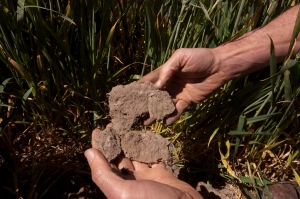Soil sampling in the spotlight
Soil sampling in the spotlight
Author: media@grdc.com.au | Date: 13 Feb 2020

Growers dealing with highly variable soils are encouraged to take up to 30 soil samples in problem paddocks to ensure accuracy in test results, which will help to ensure they are not under-fertilising or over-fertilising crops.
That is one of the key messages from CSIRO scientist Yvette Oliver, who will be presenting her research at the Grains Research and Development Corporation (GRDC) Grains Research Update, Perth, at Crown Perth on February 24 and 25.
Dr Oliver says inter-row sowing and soil amelioration strategies can influence nutrient variations within the soil.
“Higher variability in soils increases the chance that growers are either over-fertilising or under-fertilising based on the average soil test value,” she said.
Dr Oliver says if a site is highly variable then more samples will be required to improve confidence in the soil test value and reduce the amount of lost income from over or under-fertilising.
“While taking more than 40 soil cores has often been recommended, this may be cost prohibitive for some growers,” she said.
“In soils with highly variable nutrients, growers can reduce the likelihood of being wrong by taking 20–30 cores.
“In our research, we found this reduced fertiliser application errors and made the cost of over or under-fertilising crops less than $10/ha for a 10 milligram per kilogram soil test value because it increased the accuracy of the result.
“In less variable soils, about 10 cores is near optimal to get an accurate soil test and also economic in terms of soil sampling time.”
As the value of fertilisers such as phosphorus increases, so too does the amount of lost income from applying the recommended rate drawn from an inaccurate soil test, Dr Oliver says.
“The higher the price of grain, the greater the economic loss from under-fertilising,” she said.
“Conversely, the higher the price of fertiliser, the greater the economic loss from over-fertilising.
“However, phosphorus fertiliser may remain in the soil for subsequent years, so this loss could be recovered by future crops.”
The two-day Grains Research Update is an important source of agronomic and industry information and resources and includes more than 50 presenters sharing the latest research results and innovations to assist on-farm profitability.
This year, the cost of attending has been reduced to encourage even greater participation from industry and growers.
The maximum price will be $300, for which participants will receive two packed days of information and a key opportunity for interaction between advisers, growers and other industry personnel.
The GRDC Grains Research Update, Perth, will be followed by five regional one-day GRDC Grains Research Update events at the following WA locations:
- Kwinana West Zone, Corrigin Recreation and Events Centre – February 27
- Kwinana East Zone, Merredin Regional Community and Leisure Centre – February 28
- Geraldton Zone, Yuna Community Centre – March 6
- Albany Zone, Jerramungup Sports Centre – March 11
- Esperance Zone, Lake King Hall – March 12.
For more information or to register for the Perth and regional events, visit the GRDC website, or contact convenor the Grain Industry Association of WA (GIWA) on 08 6262 2128 or visit the GRDC Updates and events page.
Contact Details
For Interviews
Yvette Oliver, CSIRO
08 9333 6469, 0438 982 938
yvette.oliver@csiro.au
Contact
media@grdc.com.au – West
0427 189 827
media@grdc.com.au
GRDC Project Code: CSP1801-004RTX,
